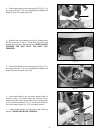
12
CHOICE OF BLADE AND SPEED
Your scroll saw will accept a wide variety of 5" flat end
blades and can be operated at any speed from 600 to
1650 cutting strokes per minute. Consider the following
as a general guideline for selecting a blade and
operating speed.
1. Use a finer blade for cutting thin workpieces, for
hard materials, or when a smoother cut is required.
2. Use a coarser blade for cutting thick workpieces,
when making straight cuts or for medium to soft
materials.
3. Use a blade that will have 2 teeth in the workpiece at
all times.
4. Most blade packaging is marked with the size of the
wood the blade is intended to cut and the minimum
radius which can be cut with that blade.
5. Slower speeds are generally more effective than
faster speeds when using thin blades and making
intricate cuts.
6. Always start at a slow speed and gradually increase
the speed until the optimum cutting speed is obtained.
LUBRICATION
To keep the scroll saw operating at peak efficiency, we
recommend that a simple maintenance procedure be
performed after each 20 hours of use (approximately)
as follows:
1. MAKE CERTAIN THE MACHINE IS DISCON-
NECTED FROM THE POWER SOURCE.
2. Tilt the table 45° to the left as shown in Fig. 28.
3. Remove four rubber grommets (A) Fig. 29 that
cover the lubrication access holes.
4. Lubricate the pivot points in each of the four access
holes with a few drops of light machine oil as shown in
Fig. 30.
5. Reassemble the four grommets as shown in Fig. 29,
to machine.
6. Apply lightweight grease or anti-sieze to lubricate
the tensioning lever (A) Fig. 15 where it pivots on the
upper chuck .
Fig. 28
Fig. 29
Fig. 30
A
BLADE BREAKAGE
Blade breakage is usually caused by one or more of the
following:
1. Bending the blade during installation.
2. Improper blade tension.
3. Improper blade selection for the work being cut.
4. Forcing the work into the blade too rapidly.
5. Cutting too sharp a turn for the blade being used.
6. Improper blade speed.
















